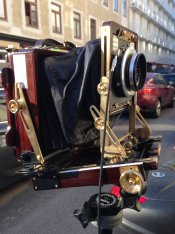Doremus Scudder
Member
Yeah, you only need a larger image circle than the film if you want to use movements that displace the image circle at the film plane. These include rise/fall, lateral shift and front tilts and swings. Back tilts and swings don't move the center of the film from the optical axis of the lens, so not much coverage is needed for those.I'd call a 200mm IC "significantly larger" than 4x5 film. But the IC does NOT necessarily have to be "significantly larger" than 4x5 film. I have two lenses that are "barely" larger than 4x5 film. That's a limitation for shifts & rise/fall -- not so much for swings & tilts. And I have lots of macro lenses with image circles much smaller than 4x5 film -- when focused at infinity, which is NEVER. How bout 12.5mm?
However, if you're photographing in close quarters in cities and stuck with a less-than-ideal camera position due to obstacles and need to use lots of front rise and then some lateral shift to get the framing you want, you'd better have some coverage. Here's a configuration that used all the coverage available from my 135mm Wide-Field Ektar (230mm). Note that I've used all available front rise and then used "point-and-tilt-parallel" to get even more effective rise, plus the shift is also maxed and a bit of point-and-swing used for even more.
I don't always need so much coverage, but when working in cities, the Nikkor 90mm f/8 with its 235mm image circle and the 135mm WF Ektar with its 230mm image circle get used a lot.
Doremus








